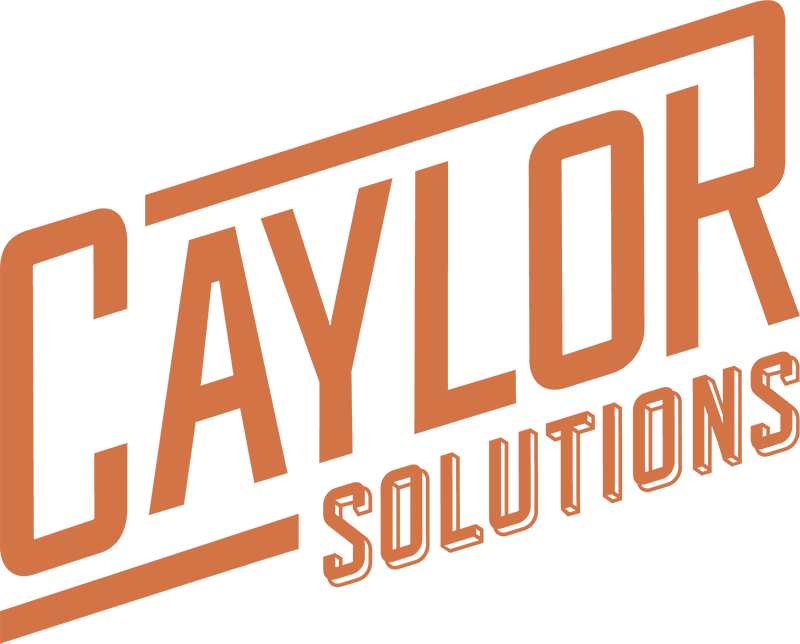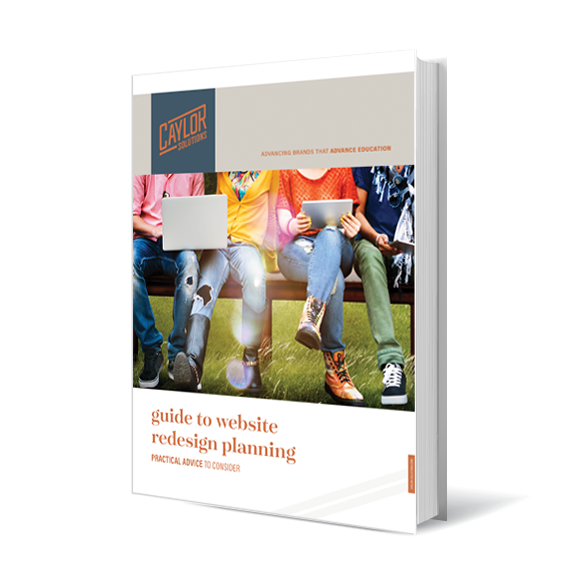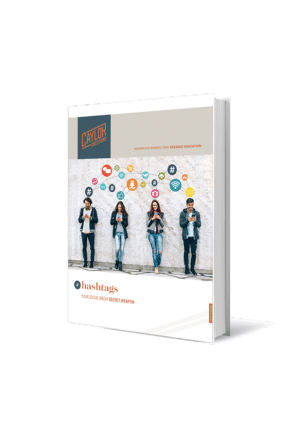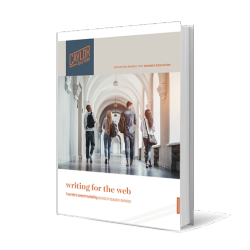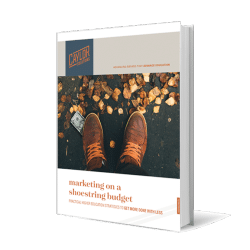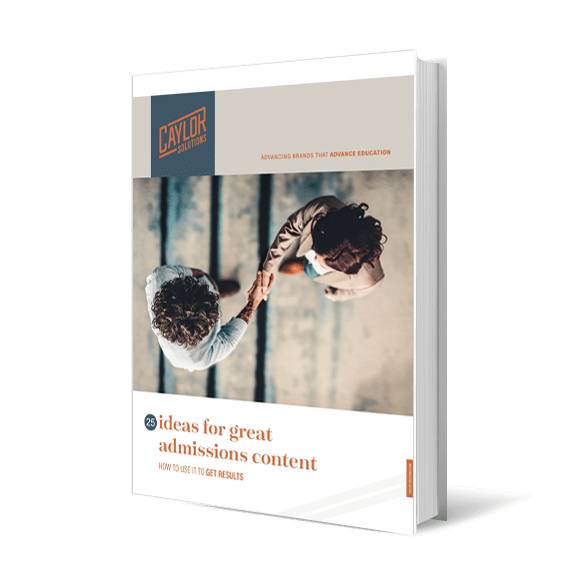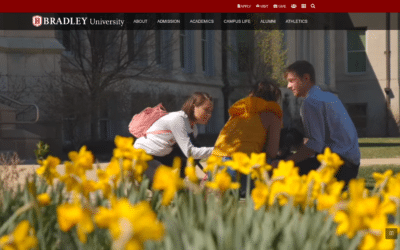Big data has worked for a lot of fast-growing brands to guide marketing messaging and decisions. But is it okay for higher ed marketers?
Over the years, I’ve been an advocate of using metrics, analytics, and big data to drive higher ed marketing decisions.
Quite often, I’m met with the legitimate concerns of good people who worry over the morality of using big data.
Are we infringing on people’s privacy rights if we use big data?
This is a good question to ask.
And I’m happy to say that the answer is “No! We’re not infringing on anyone’s rights by using big data.”
First, if you are unfamiliar with the term “big data,” please read my post where Roosevelt Smith, Principal CEO / Executive Chairman at Ewebdata.com, explains what big data is.
If you’re already familiar with this term, let’s dive into the reasons I think big data is okay for higher ed marketers to use.
People consent to have their data aggregated.
Once, I had a client, and we were doing a pay-per-click campaign for them.
As part of the overall analytical strategy, we were going to leverage pixel analytics to be able to harvest some of the people that clicked through but did not fill out the form.
Unfortunately, the client didn’t understand the value of having the analytic data.
At the end of the day, I feel they did not want to understand it.
It caused a lot of consternation because they felt like this was somehow shady behavior.
I can understand how they feel that way.
When you can get such a large amount of information on people’s habits and backgrounds, it can feel as though you’re peeking into their private lives.
But the truth is, people consent to have their data aggregated.
For one, Internet tracking technologies have been around enough that most users are familiar with the idea that their Internet habits are being tracked in order to give them a more customized experience.
Also, government regulations force companies to be transparent with how they collect and use people’s data.
Websites also must ask for permission to track a user’s behavior with cookies and other tracking technology.
These two factors are just an example to show that at some level, everyone using the Internet consents to having their data collected, aggregated, and analyzed.
Laws are in place to protect online privacy.
As mentioned above, there are laws in place protecting people’s privacy online.
Companies, much less higher education institutions, cannot just barge into people’s private lives and steal their information.
There are rules in place to protect individuals from this kind of exposure.
For example, just read this list of privacy legislation (see more about these pieces of legislation at thomsonreuters.com).
- The Federal Trade Commission Act (FTC)[1914]
- Electronic Communications Privacy Act (ECPA) [1986]
- Computer Fraud & Abuse Act (CFAA) [1986]
- Children’s Online Privacy Protection Act (COPPA) [1998]
- Controlling the Assault of Non-Solicited Pornography and Marketing Act (CAN-SPAM Act) [2003]
- Financial Services Modernization Act (GLBA) [1999]
- Fair and Accurate Credit Transactions Act (FACTA) [2003]
While the Internet may have been like the Wild West in days past, it really is not as wild or untamed.
There are laws out there that are truly protecting privacy, which should put a lot of higher ed marketers at ease when they choose to use big data.
Our online behaviors are being observed, no matter what.
Imagine you go out to a public park everyday to play fetch with your dog and talk with your family over a picnic lunch.
Now imagine a hot dog stand owner is outside in the park everyday too, trying to sell hot dogs.
One day, the hot dog owner happens to overhear your family talking about how much they love chili dogs.
The next day, the hot dog stand owner comes with a new chili sauce he’s never had before. Your family smells the amazing new menu item.
Of course, you can’t resist! You all come running to buy chili dogs.
Did the hot dog stand owner invade anyone’s privacy by listening to the conversations around him?
That’s what using big data is like.
The Internet is like one big, giant park. No matter where you go, you’re being observed.
Smart marketers keep their ears open to the conversations happening around them.
They watch other people’s behaviors around them (Who knows? Maybe the hot dog stand owner will start bringing dog treats.)
Then, they put that big data into action by improving their messaging or products for their target audiences.
Students prefer that we use big data.
For me, this last point is the real reason I think it’s okay for higher ed marketers to use big data.
Using big data is about improving relationships with your target audiences and making the enrollment experience better for them.
Here’s how Roosevelt Smith put it in our interview with him.
We can either bury our heads in the sand and keep doing marketing the way we’ve been doing, or we can lean into it.
Instead, we can educate ourselves, understand what it is to partner with trusted resources, and really make a difference in the way we’re impacting the world with our missions by extending higher education to those who are looking for it.
[With big data], you can understand who these people are [that are visiting your site], what they’re doing, and why they’re doing it. [With that information, you can build] a relationship.
You really step away from a pure transactional model and become a relationship-based solution.
By using big data, you can build relationships with prospective students.
Leveraging big data is not about manipulating anyone.
It’s about offering something that really is of value to prospective students and their families.
It is about creating marketing messaging that is less intrusive and more in line with what the prospective student is already looking for.
It’s about relationships!
Hearing their questions, offering solutions, and serving them as best you can.
This is what big data is all about.
Serving your audience better so that you can better serve your higher education mission.
For more insights into big data and other higher ed marketing strategies, feel free to contact us today.
Looking for Enrollment Marketing Content that Works?
You’re in luck! We’ve curated 25 awesome ideas inspired by top higher ed institutions across the country and put them in one handy guide: 25 Ideas for Great Admissions Content.
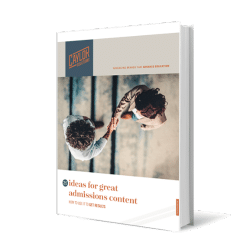
-
- 25 enrollment marketing content ideas you might never have considered before
- Guidance on how to use each one for best results
- Brief discussion on why they work to help you sell these ideas to your team
Get inspired.
Get enrollment results.
Get 25 Ideas for Great Admissions Content.
Download your copy today!
Featured image by Studio Romantic via Adobe Stock
